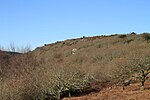Moretonhampstead railway station

Moretonhampstead railway station was the terminus of the Moretonhampstead and South Devon Railway at Moretonhampstead, Devon, England. The station opened on 4 July 1866. It was situated on the south side of the town by the road to Bovey Tracey. The platform was 300 feet long and mostly covered by a wooden train shed. Beyond the train shed was a short platform with cattle pens. South of the station was a goods shed and engine shed. The signal box was unusually built onto the side of the engine shed. In 1929 the Great Western Railway, which now owned the line, opened the Manor House Hotel just outside Moretonhampstead. Set in 193 acres (0.78 km2), it boasted a golf course and also attracted holidaymakers to visit Dartmoor. After the last passenger train ran on 28 February 1959, regular goods trains continued until 6 April 1964, although British Railways continued to use the station as a base for its road goods services until the end of the year. The goods and engine sheds for many years continued to be used by a commercial road haulage business.
Excerpt from the Wikipedia article Moretonhampstead railway station (License: CC BY-SA 3.0, Authors, Images).Moretonhampstead railway station
Station Road, Teignbridge Moretonhampstead
Geographical coordinates (GPS) Address Nearby Places Show on map
Geographical coordinates (GPS)
| Latitude | Longitude |
|---|---|
| N 50.6577 ° | E -3.7606 ° |
Address
Station Road
TQ13 8FE Teignbridge, Moretonhampstead
England, United Kingdom
Open on Google Maps









